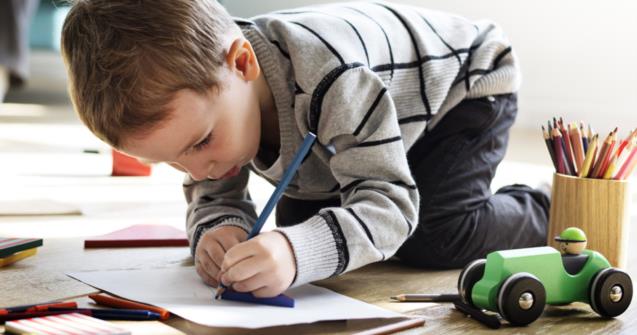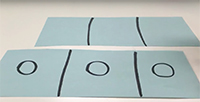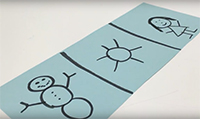
Interesting drawing practice
In terms of childhood development, the role and benefits associated with drawing are well-established. Although most children develop an interest in drawing activities and explore their potential naturally, others will need encouragement or a more explicit structure to develop their abilities.
Here is an extremely SIMPLE activity I often use. It is FUN for everyone, but beyond that, it is also ENJOYABLE for everyone and highly EFFICIENT, since it can kick-start the development of drawing abilities.
The goal of the activity?
To draw three different things using a single shape as a starting point.


How?
- Divide a strip of paper placed horizontally in front of you into three sections by drawing two vertical lines.
- Select a shape or simple drawing, for example a circle, a square, or a simple vertical line. Draw it in each section.

- Give each child a strip of paper.
- Invite children to use the chosen shape or drawing as a starting point to draw something different in each section. For example, if you drew a square in each section, a child could use one square to draw a book, another square could be the base of a house, and the third square could become a television. Ideally, have children complete this activity in different areas of the daycare, so they are unable to see what the others are drawing. Encourage them to observe objects containing the shape you drew that are present within your daycare for inspiration.

- Invite your group to sit around a table and give each child the chance to present his work. Children will appreciate discovering that their friends had ideas that were very different from their own. They will also be impressed to see that others thought of the same things, but may have represented them differently.
Learning opportunities associated with this activity:
- Building observation skills.
- Developing cognitive flexibility (ability to look at things differently, for example a rectangle and circles can also be a truck).
- Developing mental representations. Mental representations are what make drawing just about anything possible by tapping into different concepts. For example, a child many know that to draw a giraffe, he will have to draw four legs, a body, a head, and a long neck as well as use yellow and black crayons.
- Discovering the perspective of others.
- Fostering self-esteem (the structure of the activity makes the task more accessible and helps children feel competent).
Don't be surprised if children ask to repeat the activity often using the same shape or simple drawing as a starting point. This can be explained by the fact that they will be interested in experimenting and reproducing the things their friends drew to add them to their repertoire.
You will also begin to see the drawings created as part of this activity appear in children's drawings during periods of free play. If you present this activity often, children's everyday drawings will become more and more complex.
Suggested age group for this activity?
As early as 3 years old, children can appreciate watching a shape or drawing transform (the adult draws and children observe). Children can also help you find ideas by observing their environment to identify shapes. They can contribute by adding certain parts of the drawing they feel comfortable with (drawing an animal's eyes). Around 4 years old, many children can draw simple objects (ex. transform a circle to represent a face, a sun, or a ball). At 5 years old, children are capable of more complex drawings (ex. a car, a house, a flower).
Have fun!
Josiane Caron Santha, Occupational therapist

 Home
Home Theme activities
Theme activities
 Babies and toddlers
Babies and toddlers
 Arts and crafts
Arts and crafts
 Science
Science
 Creative recipes
Creative recipes
 Tips and tricks
Tips and tricks
 Special needs
Special needs
 Extra activities
Extra activities
 Educ-TV
Educ-TV
 Newsletter
Newsletter  Online store
Online store Educatall club
Educatall club

